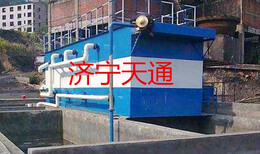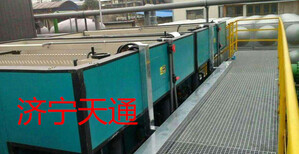上海环保水处理电镀废水处理电解式品牌保障
- ¥100.00 ≥ 1台
- 2018-07-25 17:09:59
- 天通
- 定制
- 环保水处理,电镀废水处理,环保设备,污水..
- 上海
- 范乐 13355105763
- 济宁天通机械设备有限公司
信息介绍
详细参数
上海嘉定电镀废水处理设备
电镀废水处理设备可以将电镀锌厂产生的电镀锌废水中的重金属离子锌、铁、铜、镍铬等去除干净,同时可以将电镀锌厂废水中的颜色、油污、悬浮物等都去除干净。从电镀锌厂生产工艺可将电镀废水分为前处理废水、镀层漂洗废水、后处理废水以及废镀液、废退镀液等四类。电镀废液:电镀、钝化、退镀等电镀作业中常用的槽液经长期使用后或积累了许多其他的金属离子,或由于某些添加剂的破坏,或某些有效成分比例失调等原因而影响镀层或钝化层的质量。因此许多工厂为控制这些槽液中的杂质在工艺许可的范围内,将槽液废弃一部分,补充新溶液,也有的工厂将这些失效的槽液全部弃去。这些废弃的各种浓度液一般重金属离子浓度都很高,积累的杂质也很多,不仅污染物的种类不同,而且主要污染物的浓度、其他金属杂质离子的浓度以及溶液介质也都往往有较大的差异。这些差异决定了这些废水的处理技术上的多样性和工艺上的特殊性。
废水分类
一.含铬废水:主要用还原来处理六价铬。
二.含氰废水:主要用破氰来处理。
三.其他废水:包括铜,镍,锌等。
适用范围
电镀锌厂(电镀镍、电镀锌、电镀铜等)、印刷厂(小水量印刷电镀污水)、金属制品公司(各种含有重金属电镀污水)。
处理工艺
车间电镀污水(助镀污水)——》集水池——》PH调节池——》混凝反应池——》沉淀池——》中间水池——》石英砂过滤——》清水池——》达标出水
当般采用物化法处理。处理方法较多,有效的也不少,但可以做到整体达标的并不多。但做的好的也是有的,如,陕西福天宝公司的DTCR—重金属离子捕集剂,它通过DTCR与废水中重金属离子形成一种大分子的螯合物,然后经过絮凝,可以很好的去除电镀废水中的重金属离子,并达到国家标准。
电镀锌厂废水处理设备由调节池、加药箱、还原池、中和反应池、pH调节池、絮凝池、斜管沉淀池、厢式压滤机、清水池、气浮反应,活性炭过滤器等组成。
废水排放
大多数电镀厂系综合性多镀种作业,涉及铬、镍、锌、铜等多镀种,从被镀件种类可分为金属镀件和塑料镀件,含氰电镀工艺落后虽然大部分淘汰,但亦有不少电镀厂仍在沿用。
一般电镀厂的生产工艺如下:电镀生产工艺主要为机械抛光(磨光或滚光)→除油→酸浸蚀→电镀→烘干→合格产品入库
不合格产品退镀
电镀行业实行清洁生产
清洁生产是指不断采取改进设计、使用清洁的能源和原料、采用的工艺技术与设备、改善管理、综合利用等措施,从源头削减污染,提高资源利用效率,减少或者避免生产、服务和产品使用过程中污染物的产生和排放,以减轻或者消除对人类健康和环境的危害。
镀件预处理机械抛光(磨光或滚光)
主要是借助于特制机械利用机械中的磨光轮或带(或是磨料去除某些镀件采用滚筒加磨料去锈)去掉被镀件上的毛刺、划痕、焊瘤、砂眼等,以提高被镀件的平整度提高镀件质量。此段工序无废水排放。
除油
金属制品的镀件,由于经过各种加工和处理,不可避免的会粘附一层油污,为镀层与基体的牢固结合,清除被镀件表面上的油污。除油工艺有很多种,主要采用有机溶剂除油,其工艺如下:
抛光后零件→清水洗→有机溶剂除油槽→清水槽→清水冲洗
该段工序中废水主要来源于清水冲洗过程,水质PH值在8.5—10之间。
公司简介:济宁天通水处理设备有限公司,公司位于山东省济宁市——孔孟之乡,曾子故里。公司从事小废水处理站、废水处理工艺、废水处理设备、工业废水处理设备、环保水处理、水处理设备、生活废水处理设备、环境废水处理设备等水处理设备。本公司作为的环保设备生产企业,为国内农业、石油、化工、造纸、制药、食品、淀粉、冶金、电力、煤炭、医院、生活污水及市政污水等领域的工矿企业提供了用于污水处理工程的配套设备。成为国内环保产业近年来的后起之秀。我公司拥有环保设备的设计生产资质,可为用户提供技术咨询、工艺设计、场区平面布置、设备安装和调试等完善的服务。
联系电话:
联系人:范经理
Electroplating wastewater treatment equipment in Jiading, Shanghai
The electroplating wastewater treatment equipment can remove heavy metal ions such as zinc, iron, copper, nickel and chromium in electroplating zinc wastewater produced by zinc plating plant. Meanwhile, it can remove the color, oil and suspended solids in the galvanized factory wastewater. From the production process of galvanizing plant, the electroplating wastewater can be divided into four types: pretreatment wastewater, coating rinse wastewater, post-treatment wastewater, waste plating solution, waste plating bath and so on. Electroplating waste liquid: after plating for long time, there are many other metal ions accumulated in the plating bath, such as electroplating, passivation and deplating, etc., or the quality of the coating or passivation layer is affected by the destruction of some additives or the imbalance of some effective components. Therefore, in order to control the impurities in these tanks, many factories dispose part of the tank liquid in the process permission, add new solutions, and some factories discard all the failed liquid. The concentration of heavy metals in these waste liquid is very high, and there are many impurities. Not only the pollutants are different, but also the concentrations of main pollutants, the concentration of other metal ions and the medium of solution are also quite different. These differences determine the technical diversity and technological particularity of the treatment of these wastewater.
Classification of waste water
1. Chromium containing wastewater: mainly using reduction to treat six valent chromium.
Two. Cyanide containing wastewater: mainly treated with cyanide.
Three. Other waste water: copper, nickel, zinc and so on.
Scope of application
Zinc plating plant (electroplating nickel, zinc plating, copper plating, etc.), printing plant (small water printing, electroplating sewage), metal products company (all kinds of heavy metal plating wastewater).
Treatment process
Workshop electroplating wastewater (auxiliary plating wastewater) -- "set pool" -- "PH regulating pool" -- "coagulation reaction pond" -- "sedimentation tank" -- "intermediate pool" -- quartz sand filtration -- "clear pool" - reaching the standard water.
At present, physicochemical method is generally used. There are many methods and many effective methods, but the overall standard is not much. But do well is there, such as heavy metal ions DTCR - Shaanxi futianbao company collector, it through the heavy metal DTCR in the wastewater and ion chelate forming a large molecule, then after flocculation, can be very good for removal of heavy metal ions in electroplating wastewater, and reaches the national standard.
The wastewater treatment equipment of zinc plating plant is composed of regulating pool, dosing box, reduction tank, neutralization reaction tank, pH regulating pool, Xu Ning pool, inclined tube sedimentation tank, van filter press, cleaning pond, air floatation reaction, activated carbon filter and so on.
Wastewater discharge
Most plating plants are comprehensive multi plating operations, involving chromium, nickel, zinc, copper and other kinds of plating. They can be divided into metal plating parts and plastic plating parts from the type of plated parts, while the cyanide plating process is backward, though most of them are eliminated, but many electroplating factories are still in use.
The production processes of general electroplating factories are as follows: the electroplating production processes are mainly mechanical polishing (polishing or rolling), degreasing, acid etching, electroplating, drying, and qualified products warehousing.
Disqualified product retreating
Clean production in electroplating industry
Cleaner production is continually taken to improve the design, use of clean energy and raw materials, the use of advanced technology and equipment, improvement of management and comprehensive utilization of such measures, from the source to reduce pollution, improve resource utilization efficiency, reduce or avoid the generation and emission of pollutants in the process of production, services and products in use, in order to reduce or eliminate harm on human health and the environment.
Mechanical polishing (polishing or rolling)
Is based on the use of special machinery and mechanical polishing wheel or band (or abrasive removal of certain plating by roller and abrasive to remove burrs, rust) were plated on the scratches, overip, trachoma, in order to improve the flatness of the plated piece to improve plating quality. There is no waste water discharge in this section.
Oil removal
The plating parts of metal products will inevitably adhere to a layer of oil contamination due to various processing and processing. In order to ensure the solid combination between the coating and the substrate, the oil stains on the surface of the plated parts must be removed. There are many kinds of oil removal technology, mainly using organic solvent to remove oil, its process is as follows:
After polishing parts, clean water washing, organic solvent deoiling trough, clean water trough and clean water rinsing
In this process, the wastewater is mainly derived from the process of rinsing with clear water, and the pH value of water is between 8.5 and 10.
Contact phone:
Contact: Manager fan



- 天通
- 环保水处理,电镀废水处理,环保设备,污水..
- 污水处理成套设备
- 上海
- 范乐
- 天通
- 定制
- 是
环保水处理信息
-
 饺子机价格,评价好的饺子机,最省电的饺子机¥ 24000
饺子机价格,评价好的饺子机,最省电的饺子机¥ 24000 -
 培根肉是什么部位上的肉?培根肉是猪肉¥ 111
培根肉是什么部位上的肉?培根肉是猪肉¥ 111 -
 吲哚胺2,3双加氧酶1IDO1科研检测试剂盒/全种属代测免费¥ 1
吲哚胺2,3双加氧酶1IDO1科研检测试剂盒/全种属代测免费¥ 1 -
 邢台道口警示桩厂家按图生产面议
邢台道口警示桩厂家按图生产面议 -
 通辽代写设备租赁投标书¥ 1000
通辽代写设备租赁投标书¥ 1000 -
 东莞东坑哪里有防水补漏公司面议
东莞东坑哪里有防水补漏公司面议









